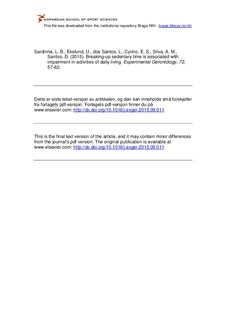| dc.contributor.author | Sardinha, Luis B. | |
| dc.contributor.author | Ekelund, Ulf | |
| dc.contributor.author | dos Santos, Leandro | |
| dc.contributor.author | Cyrino, Edilson S. | |
| dc.contributor.author | Silva, Analiza M. | |
| dc.contributor.author | Santos, Diana A. | |
| dc.date.accessioned | 2017-01-24T16:07:19Z | |
| dc.date.available | 2017-01-24T16:07:19Z | |
| dc.date.issued | 2015-12 | |
| dc.identifier.citation | Experimental Gerontology. 2015, 72, 57-62 | nb_NO |
| dc.identifier.uri | http://hdl.handle.net/11250/2428204 | |
| dc.description | I Brage finner du siste tekst-versjon av artikkelen, og den kan inneholde ubetydelige forskjeller fra forlagets pdf-versjon. Forlagets pdf-versjon finner du på www.elsevier.com / In Brage you'll find the final text version of the article, and it may contain insignificant differences from the journal's pdf version. The definitive version is available atwww.elsevier.com | nb_NO |
| dc.description.abstract | Identifying modifiable behaviors associated with prevention of activities of daily living (ADL) impairments is vital to implement preventive strategies for independent living in elderly. We aimed to examine the associations between objectively measured breaks in sedentary time with ADL impairments and physical independence. Cross-sectional assessments were carried out in 371 participants (131 male) aged 65–103 years from the Portuguese surveillance system of physical activity. Physical activity (PA) and sedentary time (ST) were assessed with accelerometry, and ADL impairments and physical independence with the self-reported 12-item composite physical function scale. Using ROC analyses a cut-off of 7 hourly breaks in sedentary time was identified which maximized the sensitivity and specificity in diagnosing physical dependence. Logistic regression analysis demonstrated that, independently of moderate-to-vigorous PA (MVPA), participants performing ≤ 7 hourly breaks in sedentary time had 2 to 7 fold increased odds for impairment in 10 of the 12 ADL. When stratifying ADL into basic, instrumental and advanced ADL we verified that less than 7 hourly breaks in sedentary time was associated with a 2 to 5 fold increased odds for impairments and physical dependence, independent of MVPA. No associations were observed between meeting PA guidelines and basic, instrumental, and advanced ADL impairment although time in MVPA was lower in participants showing impairments. In conclusion, the frequency of breaks in sedentary time in older ages is independently associated with lower risk for ADL impairments and physical dependence. Our findings support interventions to encourage older adults to increase overall PA by interrupting sedentary time | nb_NO |
| dc.language.iso | eng | nb_NO |
| dc.publisher | Elsevier | nb_NO |
| dc.subject | breaks in sedentary time | nb_NO |
| dc.subject | sedentary time | nb_NO |
| dc.subject | physical activity | nb_NO |
| dc.subject | ADL impairment | nb_NO |
| dc.subject | physical independence | nb_NO |
| dc.title | Breaking-up sedentary time is associated with impairment in activities of daily living | nb_NO |
| dc.type | Journal article | nb_NO |
| dc.type | Peer reviewed | nb_NO |
| dc.subject.nsi | VDP::Medisinske Fag: 700 | nb_NO |
| dc.source.journal | Experimental Gerontology | nb_NO |
| dc.identifier.doi | http://dx.doi.org/10.1016/j.exger.2015.09.011 | |
| dc.description.localcode | Seksjon for idrettsmedisinske fag / Department of Sports Medicine | nb_NO |
